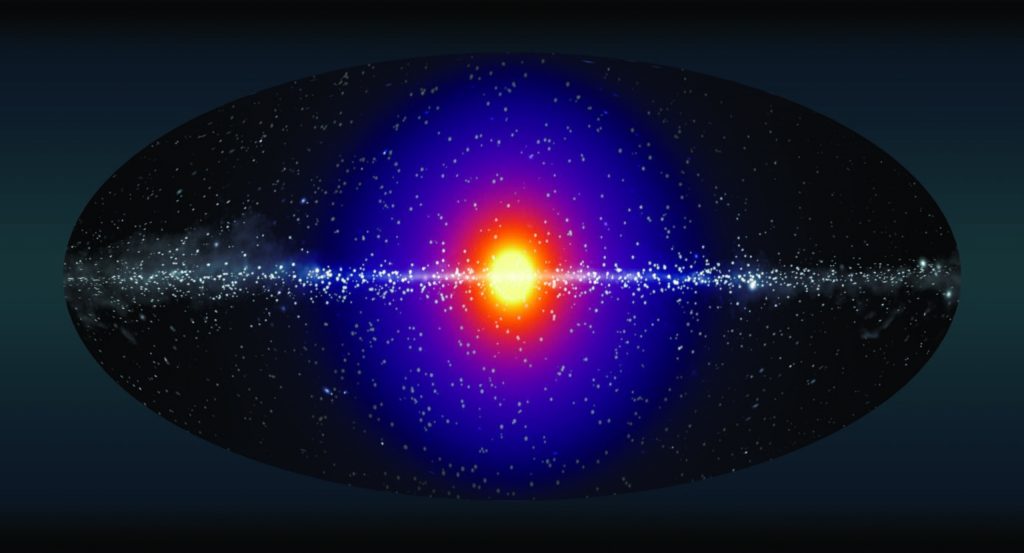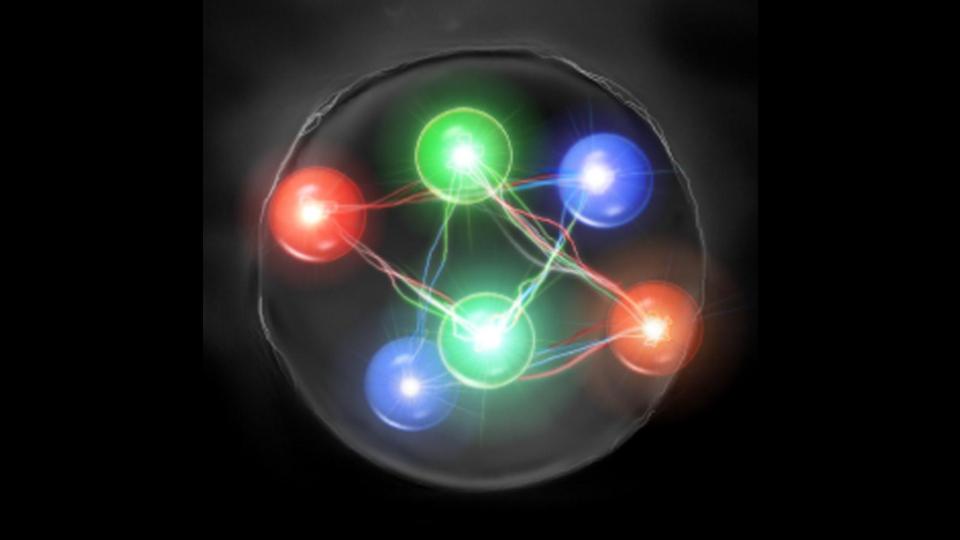
Scientists look for dark matter in places close to home – and study flickers of light that might be created by dark matter, called sterile neutrinos – to find the mysterious substance. And the discovery of stable 6-particle quarks called hexaquarks might turn out to be mysterious dark matter.
Links
Searching for Dark Matter inside Neutrinos
- Researchers look for dark matter close to home (U Michigan)
- How Do We See Dark Matter? (NASA)
- New Technique Looks for Dark Matter Traces in Dark Places (Berkeley Lab)
- Sterile Neutrino (ArXiv pdf)
Hexaquarks
Transcript
This is the Daily Space for today, Monday, March 30, 2020.
Welcome to the the Daily Space, I am your host, Dr Pamela Gay, and I am here to put science in your brain. Most Mondays through Fridays either I or my co-host Annie Wilson will be here, bringing you a quick run down of all that is new in space and astronomy.
It is spring and as we all shelter in place, the excess of daylight is easy to miss. It seems only fitting that in this dark time we should take a moment to talk about dark matter.

When we look out at the motions of large and larger objects, we see behaviors that can only be explained if there is more material out there than we can see without telescopes. Discovered by both Vera Rubin and Fritz Zwicky, who were looking at galaxies and galaxy clusters, today we know that at least 25% of the mass-energy of the universe is hidden in this mysterious stuff. Initially, it was hoped that if we just look harder and in new wavelengths, we’d uncover this stuff in the form of gas, dust, black holes, and rogue planets. When I was in graduate school, the emptiness of our universe and the scale of this problem was proud home to me when professor Don Winget pointed out that you could account for all the dark matter by placing one acme brick in each solar system sized volume of space. Our universe is seriously empty, and we’re looking for stuff that adds up over the size of the universe, but in general just isn’t all that much stuff.
In the 1990s and early 2000s, teams searched for black holes and other dark objects that might be hiding out in plain sight. Specifically, they looked toward our galactic bulge, and toward the Magellanic Clouds and looked for the gravity of nearby objects to gravitational lens the distant stars and make them temporarily seem brighter. While these projects did see gravitationally lensed things, including at least 1 planet!

What they found wasn’t nearly enough to account for all dark matter effects we see. At the same time that observers were ruling out normal things being dark matter, other astronomers were thinking through how clouds of dark matter particles could gravitationally reshape images of distant galaxies, allowing us to look for dark matter that was nothing more than a distribution of particles – and we found this. The Bullet Cluster image was perhaps the most famous example of how dark matter has been mapped by looking at how it reshapes our view of what lurks behind it.
The only thing is, these particles don’t seem to interact through the electro-magnetic force in normal ways – they don’t produce or interact with light except through gravitational tugs on photons. We don’t have reason to think that it interacts with magnetic fields, and in general, most of our normal ways of seeing things are defeated by dark matter.
And dark matter’s way of hiding only makes us want to find it all that much more, and astronomers and physicists around the world are struggling to find new ways to detect patricals.

CREDIT: Zosia Rostomian and Nicholas Rodd/Berkeley Lab; Christopher Dessert and Benjamin Safdi/University of Michigan; Fermi Large Area Telescope
In a new study from a collaboration by folks at the University of Michigan, Lawrence Berkeley Labs, and UC Berkeley sought to see if maybe, mysterious flickers of light from nearby galaxies might be caused by dark matter. These flickers are believed to be from a theorized particle called a sterile neutrino, and they appear as XRay flickers in massive galaxies. It was thought that decay of sterile neutrinos might be producing this line.
This begs the question, what is a sterile neutrino? We have no experimental evidence that requires these particles to exist, but most observed particles in the standard model come in different varieties that complimentary spin. All observed neutrinos to date have a left-handed spin, sterile neutrinos are theorized as the right handed spinning version of this hard to study little particle – a particle that acts an awful lot like dark matter in terms of not interacting. It was hoped that the sterile neutrino would prove real and prove to be at least part of the solution for dark matter.
Analysis of data from the XMM-Newton looking at the flickers in large galaxies to see if they could be proven to be caused by sterile neutrino decay was consistent with big galaxies having lots of decays to go with their lots of dark matter. This should mean that smaller galaxies, like our own Milky Way, should have the same flickers in proportion to the size of our galaxy. The thing is… observations don’t show that. By going through all the archives of XMM data they could, this team searched near and far in our Milky Way and there were no flickers to be seen. This indicates that whatever causes these flickers is unique to the environment of large galaxies – and dark matter isn’t unique to any location, so… the flickers and dark matter can’t be linked in a way we can understand.
We may still be able to blame sterile particles for dark matter, but the flickers aren’t sterile neutrinos decaying.

Coming up with and then finding new particles is very much the quest of dark matter researchers. The “coming up with” particles park is easy – math makes it possible to define all sorts of things. It’s the finding of the particles that is hard.
But things that are hard, aren’t impossible.
Everything in the universe is made up of particles and energy. Regular matter is made of fundamental particles like electrons, and composite particles like protons that are made up of combinations of 3 quarks. As far as we know, all stable composite particles – leptons – are made of 3 and only 3 quarks. But quarks don’t have to come together in groups of 3, and we don’t necessarily know about everything that is out there.
Using massive particle colliders, we have been able to slam together bits of regular matter with so much force that it turns into almost pure energy that re condenses into myriad stable and unstable particles. In these flashes of unstable particles configurations of 4 and 5 quarks have been discovered. It is now theorized that 6-quarks may be able to come together to form stable particles. Called hexaquarks, these undiscovered particles are being actively sought as a dark matter candidate. Researcher Glennys Farrar at NYU has theorized that these particles may be trapped inside various elements in the crust of the earth, such as oxygen-18. Folks are literally weighing different oxygen-18 atoms to see if they can measure the excess weight hexaquarks might cause. Folks are also looking through results from past particle collisions at the world’s various accelerators, and there are hints of a large particle in data from Germany’s WASA experiment at the COSY particle accelerator. It looks like there might be a 2.4 billion electron volt particle in the data, and this is consistent with a 6 quark particle. It isn’t conclusive, but it’s a hint, and this is the best we’ve got right now.
Other researchers are also looking for flickers in neutrino detectors that aren’t caused by neutrinos and could be dark matter, and others are simply brainstorming new possibilities.
But no one can really say exactly what dark matter is. The best we’ve got, based on observations, is dark matter is a particle that is a pain in the expletive to find.
And that’s all I’ve got. Not even dark matter wants to hangout with us in these dark times. While dark matter may not be showing up for the shelter-in-place party, we want you to know we’re going to show up for you.
<———————>
As part of helping keep us all occupied in these really weird times, we’re going to be hosting a lot of additional content on our Twitch channel, and we want to remind you that CosmoQuest has an active community on Discord where you can talk science and even find other people to join you in playing some online games. You can find links to everything that is going on at CosmoQuest.org.
Thank you all for listening. Today’s script was written by Pamela Gay, and the Daily Space is produced by Susie Murph. The Daily Space is a product of the Planetary Science Institute, a 501(c)3 non profit dedicated to exploring our Solar System and beyond. We are here thanks to the generous contributions of people like you. The best way you can support us is through Patreon.com/cosmoquestx Like us? Please share us! You never know whose life you can change by adding a daily dose of science.


 We record most shows live, on Twitch. Follow us today to get alerts when we go live.
We record most shows live, on Twitch. Follow us today to get alerts when we go live.